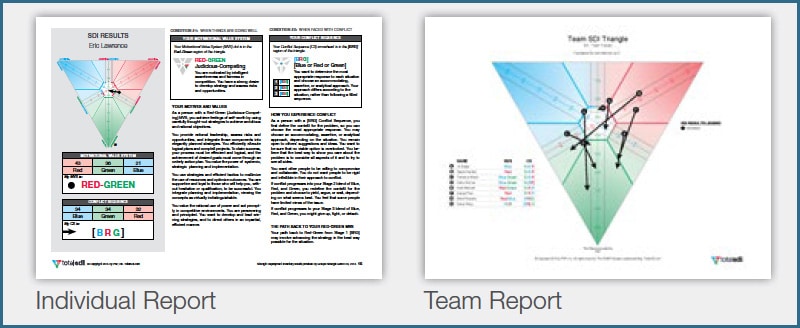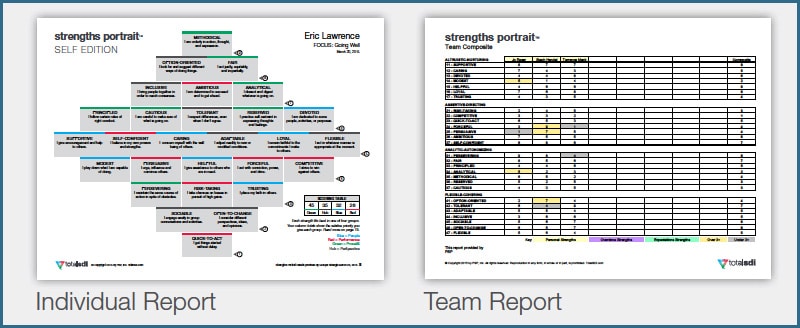Assessments of Strengths and Motivations
Four powerful questions to engage your clients and expand your business
A recent Deloitte study identified the top four critical challenges facing every organization today — leadership, engagement, culture, and performance and great organizations work through these challenges by answering the following questions.
- Leadership: Where are tomorrow’s leaders coming from?
- Engagement: What drives your most engaged people?
- Culture: How do your people interact to achieve the organization’s goals?
- Performance: How do you connect workplace behavior to personal motivations?
Total SDI provides the data essential to answer this these questions.
The Questions You Need To Ask
Where Are Tomorrow’s Leaders Coming From?
Leadership begins with managers who hone their personal and interpersonal skills.
To become leaders, managers must learn how to influence people, give feedback, drive change and produce results. It’s about learning what’s important to each member of the team, eliminating faulty assumptions and working through misunderstandings that arise as a result of different communication styles.
This requires self-awareness and the ability to connect with people from different backgrounds, generations, and values. We develop such skills through intentional effort, comprehensive tools and, most importantly, insightful experiences that allow for practice.
The most effective leaders are those who use effective behaviors (strengths) to build strong relationships with their team and broader networks. These leaders are positioned to take on greater responsibilities in the future and to, ultimately, succeed.
What Drives Your Most Engaged People?
The most engaged employees have a heightened sense of ownership.
They give meaning to their work by connecting their motives, values and personal sense of purpose with their work. In fact, they have such a strong sense of alignment that their daily tasks become an expression of who they are and what they care about most. As a result, they take initiative and stretch themselves by trying new ways of interacting with others to get the results they need.
This sense of ownership is nurtured when employees feel understood and valued. The key is using TotalSDI as the common language to identify and discuss what motivates employees and activates a deeper level of personal responsibility.
How Do Your People Interact to Achieve the Organization’s Goals?
Healthy cultures support new ideas and offer an environment where people can express themselves freely and without fear.
They invite opposing views and encourage dissenters to offer a better way, with each person’s voice and view honored through respectful and authentic conversation.
Building this healthy culture requires managers who have keen self-awareness and the interpersonal skills to communicate in ways that are both genuine and effective. They invite honest dialogue while maintaining an appreciation for different communication styles. Effective communication occurs when open collaboration and respectful disagreement are embraced without anyone feeling threatened or under personal attack.
Organizations filled with people who can do this have vibrant cultures that encourage great work?
How Do You Connect Workplace Behavior to Personal Motivations?
When people want to do what they have to do they become self-directed and accountable for key results.
Top consultants use TotalSDI’s suite of assessments to create powerful and memorable learning experiences that address the interpersonal components of effective leadership, high employee engagement, and healthy organizational culture. Whether it’s training, coaching or consulting, TotalSDI makes it easy to provide insights and apply those concepts in everyday situations.
Organizations need leaders who focus on developing efficient work processes (the what) and effective interpersonal processes (the how). Unfortunately, most leaders concentrate their time and energy on building work processes, while most problems and challenges arise from interpersonal processes. The key is connecting the behavior to your own personal motivation (the why) — be it people, performance or process. Everyone needs to understand what is driving choices about how to behave and communicate, and how those choices and actions are perceived by others.
Create Powerful Learning Experiences with TotalSDI
TotalSDI identifies intrinsic motives with eight in-depth assessments that target the priorities and values impacting behavior. TotalSDI’s interactive design creates a powerful learning environment for leaders and teams, as the learner’s own words and insights fuel the classroom dynamic while you guide the discussion and draw out performance-enhancing practices that stick.
The TotalSDI Suite of Assessments includes:
Strength Deployment Inventory

But the SDI also goes further than the individual. It provides a Team SDI Triangle report, your results and the results of your teammates, so you can see where motives align, correspond and even conflict. This visual makes it easier for people to interpret and discuss the results, leading to greater understanding and stronger collaboration.
As you work through a team’s individual and group results, you will help them learn how to better relate to others, prevent unproductive conflict and improve their own performance.
Strengths Portrait

Portrait results, you will help others gain an instant understanding of how they decide what is important and what is not. Learners in your session will see why others may have different priorities and learn to flex their communication styles and combine priorities when inevitable conflicts occur and maintain a positive dialogue throughout.